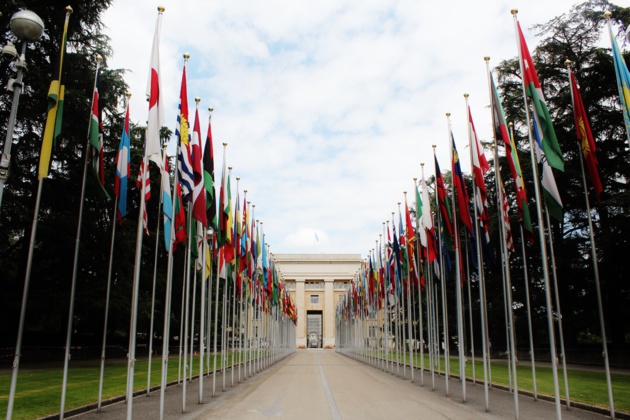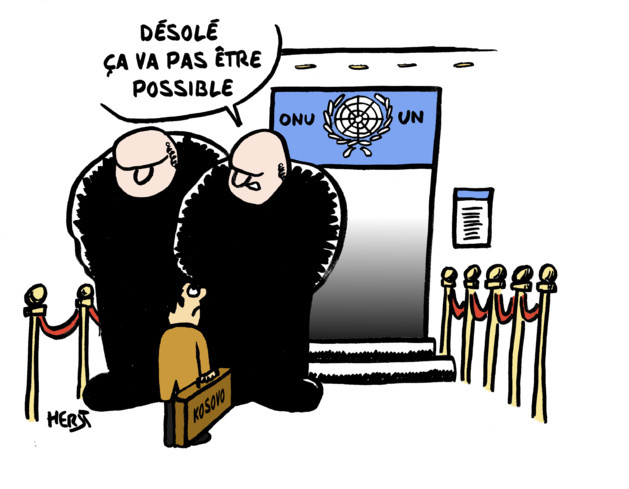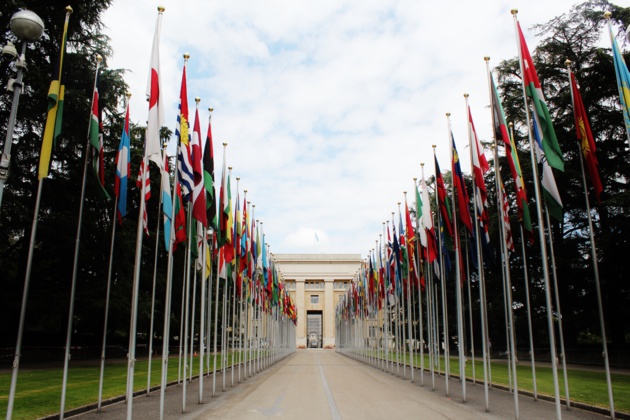
Credits Mélanie Lorrain
According to the UN: “the acknowledgement of new State or a new government is an act that only the other States and governments can do. The UN, being neither a State nor a government, is not entitled to acknowledge a State or government”. In order to become a member of the organization, the candidate state must submit an application to the Secretary General, as well as a letter in which it accepts all terms of the Charter. The next step is taken by the Security Council, which examines the request before it is subject to a vote by the 193 members. South Sudan is the latest State to have joined the organization in July 2011, after seceding from the Republic of Sudan, therefore ending decades of civil conflict. Many other countries aspire to become UN member States but are still not considered as such. Who are they?
Kosovo
The Kosovo region came under the administration of the UN with the 1244 resolution of the Security Council; the latter’s goal being to maintain peace in the region after the war against Serbia. Kosovo, a Serbian territory having a mainly Albanese population, declared its independence in 2008. To date, its autonomy is recognized by 110 UN member States and by Taiwan. Numerous challenges hide behind this independence and even within the European Union. The acknowledgement of Kosovo creates a challenge for certain countries that are afraid to legitimize those issues as they have important separatist movements on their own territories. It is the case for Spain with its Basque and Catalan regions.

December 2008: EULEX Kosovo, the civil mission of the EU aiming at increasing Kosovo’s autonomy, proposed a partition of the region between Serbs and Albanese to end the conflict, with the consent of Moscow, Belgrade, the EU and the US. Kosovo is still not a UN member State because two of its permanent members, China and Russia, used their veto right and declared the independence of this region illegal. Kosovo seems to wish to connect with Albania though and not to become a sovereign state. After the independence of Montenegro, Kosovo would be a second substantial territorial loss for Serbia. That is what makes negotiations so complicated.
South Ossetia & Abkhazia
These are secessionist regions of Georgia. In the 1980s, a wind of independence blew in the “Republics of the Soviet Unions”, namely Georgia, Ukraine, Moldavia and Azerbaijan. To smother it, the soviet government encouraged separatists of certain regions to rebel against their governments. This support has played inhabitants against one another. This latter also aimed at placing the soviet forces as arbitrators. South Ossetia and Abkhazia are heirs of this policy. South Ossetia, autonomous oblast under the Soviet Union, saw its autonomy being revoked by Georgia when the USSR fell, considering Ossetians as a minority and their autonomy illegitimate. An armed conflict broke out in 1991 between the Georgian army and Ossetian militias; the latter being supported by North Ossetia and Russia. This conflict ended in 1992 thanks to a peace treaty signed between Georgia and Russia, as well as by the signature of the declaration of independence of south Ossetia the same year.
In 1992, new hostilities arose in Abkhazia. Under the same conditions as those in South Ossetia, Abkhazia rebelled against Georgia and declared its independence, backed by Russia. The conflict ended in 1993 under the aegis of Russia.
In August 2008, Georgia attacked South Ossetia trying to regain control of the territory. Fighting spread all the way to Abkhazia, before Georgia got violently pushed back and partially occupied by Russia, while the eyes of the world were on the Beijing Olympic Games. The conflict lasted one month before a ceasefire was concluded. Today, the independence of Ossetia and Abkhazia are recognized by Russia, Nicaragua, Venezuela, as well as Nauru. Tuvalu and Vanuatu islands recognized their independence for a while before retracting their position. The goal of South Ossetia and Abkhazia seems to be to become autonomous republics relating to Russia in the long term. An attachment to Russia has not officially been considered by the latter in order not to fuel the situation with Georgia. However, the Kremlin affirmed to “be ready to ensure the safety of both states”. Russian passports have actually been unofficially supplied to residents of the region.
Nagorno-Karabakh
Situated between Azerbaijan and Armenia, with 80% of the population being Armenians, this region declared its independence from Azerbaijan in 1991, having Soviet support since the 1980s. A war followed, causing thousands of casualties and hundreds of thousands of refugees on both sides of the borders, until a ceasefire was signed in 1994. As for Kosovo, South Ossetia and Abkhazia, the strategy for Nagorno-Karabakh is to become independent from Azerbaijan to then relate to Armenia. A geographical shuffle would force Azerbaijan to let go of a substantial part of its territory. The issue of recognizing Nagorno-Karabakh as a member of the UN has never been raised and only three entities recognize its independence: Abkhazia, South Ossetia and Transnistria.
Transnistria or the Pridnestrovian Moldavian Republic
Situated between Ukraine and Moldavia, Transnistria (RMN), like south Ossetia, Abkhazia and Nagorno-Karabakh, got into conflict with its motherland Moldavia following the soviet support to separatists. When the Moldavian government decided to adopt Romanian as the official language of the country in 1990 (a third of the country is Romanian-speaking, 1/3 is russian-sepaking), Russian and Ukranian minorities in the region feared a possible annexing of Moldavia to Romania. In 1992, an agreement was reached between Russia and Moldavia, declaring RMN as a autonomous Moldavian region provided that it remained bilingual (Romanian and Russian) and that Moldavia rejected the idea of being attached to Romania. The independence of Transnistria is today only recognized by South Ossetia, Abkhazia and Nagorno-Karabakh. The debate concerning its possible annexation by Russia was re-fueled by the appropriation of Crimea by Russia.
New Russia or the Union of People's Republics
Also in the sphere of influence of Russia, New Russia was born in 2014 from the union of old Soviet oblasts after the Ukrainian crisis; the Donetsk People's Republic and the Luhansk People's Republic. This southern part of Ukraine detached itself from the country after the annexing of Crimea by Russia. However, both the UN and Russia recognize this territory. The Ukrainian crisis still being current, the status of the region is uncertain, such as the future of Ukraine.
The Turkish Republic of Northern Cyprus
The reasons for the secession of the northern part of Cyprus date back to the Russo-Turkish war (1877-1979). The island was “rented” to the UK by Turkey in exchange for support during the war. While the island was under British authority, the Greek Cypriots demanded to be bound to Greece several times. The UK refused every time arguing that the island was still officially part of the Ottoman Empire. After years of political instability and the declared independence of Cyprus in 1960, the northern part of the country decided to declare its own independence in 1983. This latter is only recognized by Turkey and blocks the entry of Cyprus in the Schengen area, despite is membership to the European Union in 2004.
The Sahrawi Arab Democratic Republic
Western Sahara is occupied by Spain but Morocco is claiming its sovereignty on the territory. In 1975, Moroccans organized the Green March, a pacifist event in order to annex the region. Following the walk, Spain signed the Madrid agreements and decided to share the territory between Morocco and Mauritania. In 1979, Mauritania signed a peace agreement with The Sahrawi Arab Democratic Republic (SADR) and gave up the part of the region attributed to them. Morocco annexed the latter later in the 1980s and built the “Moroccan wall”. Morocco now controls 80% of the SADR’s territory despite the UN perceiving the situation as an unfinished colonization process and the African union as an African state.
Taiwan or the Republic of China
After Japan’s defeat in WWII, the Republic of China seized the island and Kuomintang’s government settled there in 1949 after their defeat against Chinese communists. The Republic of China was a permanent member of the UN until 1971 when the People's Republic of China claimed its authority over the island. Taiwan is now recognized by 22 states of the 193 members of the UN. For the international organization, Taiwan is a province of the People's Republic of China, whereas the Republic considers the island as its own like the rest of the Chinese territory. For the sake of greater relations with the People's Republic of China, the Republic of China officially continues to exercise its authority on the territory without true vehemence.





























